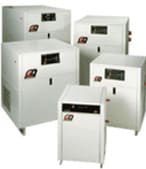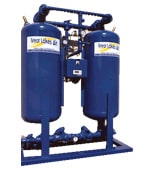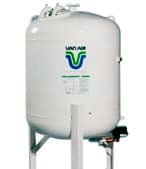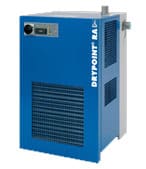Cycling and Non-Cycling Refrigerated Air Dryers
Compressed air dryers reduce the quantity of liquid, water, water vapor, hydrocarbon and hydrocarbon vapor in compressed air systems.
Refrigerated air dryers can be the solution to getting the water and moisture out of your Compressed Air System. The refrigerated air dryer cools the incoming compressed air through a heat exchanger where the outgoing cool dry air pre-cools the hot incoming air and condenses some moisture out. The incoming air enters an air-to-refrigerant heat exchanger where the air is cooled to 38º F by the liquid refrigerant. This process causes the moisture to condense into liquid water and it is drained away. The outgoing air then enters the heat exchanger and is warmed to keep the exterior pipes from sweating.
The refrigeration compressor pumps high-pressure gas refrigerant into the condenser, which transfers the heat from the refrigerant gas to the ambient air as the gas condenses into a liquid. The liquid refrigerant is then metered to a cold low-pressure where it enters the heat exchanger. Then the heat from the hot compressed air absorbs into the cold refrigerant and the refrigeration compressor sucks low-pressure hot gas refrigerant into the refrigeration compressor and the cycle starts over again.
Non-cycling refrigerated air dryers have refrigeration compressors that start as soon as you turn the dryer on ― and don’t stop until you turn the dryer off. They are less expensive than cycling dryers and are a good choice for applications where they will constantly run at full capacity. However, they can experience problems during periods of low compressed air usage.
Non-cycling refrigerated dryers are equipped with a device called a hot gas bypass valve, which sends the heat that the refrigeration compressor would normally discharge to atmosphere back to the cold side of the system to keep it from freezing.
Cycling refrigerated dryers have refrigeration systems that run when cooling is needed and shut off when it is not. If you use less compressed air, or the ambient temperature is cooler, you will use less electricity and put less running time on the refrigeration compressor and condenser fan motor(s). The electrical savings from cycling dryers can add up.
Desiccant Air Dryers
Desiccant air dryers utilize chemicals beads, called desiccant, to absorb water vapor from compressed air. Silica gel or activated alumina is the preferred desiccants for compressed air dryers.
Desiccant air dryers are usually configured with two pressure vessels, filled with desiccant switching valves to direct the compressed air flow and controls for proper switching of the desiccant air dryers’ vessels. Single tower versions are available.
Basic operation of a desiccant air dryer consists of one drying cycle and one regeneration cycle, commonly referred to as the NEMA cycle. For example, a 10 minute NEMA cycle consists of a 5 minute drying cycle and 5 minute regeneration cycle. This cycle is continuously repeated.
During the drying cycle, compressed air, at full pressure, flows through one desiccant vessel. As the air flows through the desiccant bed, microscopic pores on the surface of the desiccant beads "strips" the water vapor and hydrocarbon molecules from the air, thereby reducing the relative humidity of the air. The relative humidity of the dried air is equivalent to a pressure dewpoint of -40 degrees F or lower. Since this "stripping" action by the desiccant beads is a result of a chemical reaction, it produces a small amount of heat, called "heat of adsorption." The heat produced is minimal and increases the outlet temperature only slightly.
During the regeneration cycle, the switching valves isolate the moisture saturated desiccant vessel, this "off-line" vessel is depressurized and the desiccant regeneration process begins. Following regeneration, the vessel re-pressurized with compressed air, is again ready for the next drying cycle.
Desiccant air dryers are available in two basic designs, heatless and heated. Since the drying cycle on all desiccant air dryers is similar, the difference between heated and heatless designs is found in the regeneration methods.
What's Your Application Need?
Most refrigerated air dryers cool the compressed air to an approximate temperature of 35 degrees F to 50 degrees F, which results in a pressure dewpoint range of 33 degrees F to -39 degrees F.
For desiccant dryers the relative humidity of the dried air is equivalent to a pressure dewpoint of -40 degrees F or lower.
What's Here to Offer!
C & B Wichita, Inc. provides expert advice for every application in your facility. With an array of products to suit your needs, the following respectful manufactures have offerings to remove moisture from your compressed air distribution system.
Gardner Denver
Hankison
Great Lakes
Van Air
Refrigerated and Desiccant Air Dryers, Deliquescent Air Dryers, Filters, Oil/Water Separators





